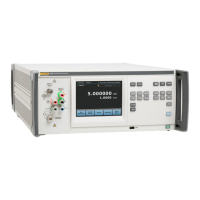Remote Commands
Use of *OPC?, *OPC, and *WAI 6
6-11
Table 6-6. Command Summary
IEEE-488.2 Common Commands
*CLS
Clears status. Clears the ESR, the ISCR, and the error queue. Terminates a
ending operation complete command (*OPC).
*ESE Sets event status enable register, described in Status Information section below.
*ESE?
Returns the decimal equivalent of the event status enable register, described in
Status Information section below.
*ESR?
Returns the decimal equivalent of the contents of the event status register (ESR)
and clears it.
*IDN?
Identification query. Gives an <IAD> that identifies the Model number, instrument
serial number, and firmware revision levels.
*LRN?
Returns <IAD>, which when sent to the Product restores it to the state in effect
when the *LRN? command was executed.
*OPC
Generates the operation complete message in the Event Status Register when all
pending device operations have been finished.
*OPC? Replies with a 1 when all pending operations are complete.
*OPT? Queries which hardware and software options are installed.
*PUD
Protected user data command. This command allows the user to store a string of
bytes in a nonvolatile location in the Product. The CALIBRATION secure state
must be set to off (otherwise an execution error occurs). An execution error also
occurs if the argument is over 64 bytes long.
*PUD? Protected user data query.
*RCL Restores the Product setup from a previous setup saved by *SAV.
*RST
Resets the state of the instrument to the power-up state, except that continuous
triggering is stopped.
*SAV Saves the current Product setup into a setup save area for later use by *RCL.
*SRE
Sets Service Request Enable register, described in the Status Information section
below.
*SRE?
Query Service Request Enable register, described in the Status Information
section below.
*STB?
Reads status byte. The status byte is described in detail in the instrument status
section below
*TRG Executes the TRIG command
*TST?
Checks the nonvolatile storage area (calibration constants and instrument
settings). Also see DIAG.
*WAI
Wait-to-Continue Command. This command prevents further remote commands
from being executed until all previous remote commands have been completely
executed.

